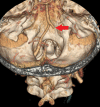Neurogenic pulmonary oedema complicating a lateral medullary infarct
- PMID: 30054324
- PMCID: PMC6067143
- DOI: 10.1136/bcr-2018-225437
Neurogenic pulmonary oedema complicating a lateral medullary infarct
Abstract
Neurogenic pulmonary oedema (NPO) is a rare clinical syndrome of pulmonary oedema occurring secondary to an insult of the central nervous system (CNS). The exact aetiology of this disorder is unknown. NPO can be fatal and poor awareness and identification of this entity, particularly in terms of misdiagnosis as primary pulmonary or cardiac disease, can result in suboptimal management and outcomes. We describe the presentation and management of a 68-year-old woman with an acute left lateral medullary stroke complicated by pulmonary oedema. The likely aetiology is discussed, and important learning points are highlighted.
Keywords: brain stem / cerebellum; heart failure; neuroimaging; neurology; stroke.
© BMJ Publishing Group Limited 2018. No commercial re-use. See rights and permissions. Published by BMJ.
Conflict of interest statement
Competing interests: None declared.
Figures



References
-
- Brown-Séquard CE. On the production of hæmorrhage, anæmia, œdema, and emphysema in the lungs by injuries to the base of the brain. The Lancet 1871;97:6 10.1016/S0140-6736(02)77750-7 - DOI
-
- Dragosavac D, Falcão AL, Araújo S, et al. . [Neurogenic pulmonary edema. Report of 2 cases]. Arq Neuropsiquiatr 1997;55:305–9. - PubMed
Publication types
MeSH terms
LinkOut - more resources
Full Text Sources
Other Literature Sources
